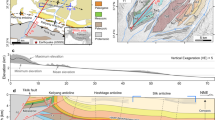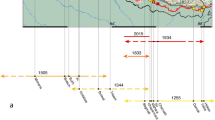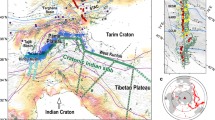Abstract
Models of Himalayan neotectonics generally attribute active mountain building to slip on the Himalayan Sole Thrust, also termed the Main Himalayan Thrust, which accommodates underthrusting of the Indian Plate beneath Tibet. However, the geometry of the Himalayan Sole Thrust and thus how slip along it causes uplift of the High Himalaya are unclear. We show that the geodetic record of the 2015 Gorkha earthquake sequence significantly clarifies the architecture of the Himalayan Sole Thrust and suggests the need for revision of the canonical view of how the Himalaya grow. Inversion of Gorkha surface deformation reveals that the Himalayan Sole Thrust extends as a planar gently dipping fault surface at least 20–30 km north of the topographic front of the High Himalaya. This geometry implies that building of the high range cannot be attributed solely to slip along the Himalayan Sole Thrust over a steep ramp; instead, shortening within the Himalayan wedge is required to support the topography and maintain rapid rock uplift. Indeed, the earthquake sequence may have included a moderate rupture (Mw 6.9) on an out-of-sequence thrust fault at the foot of the High Himalaya. Such internal deformation is an expected response to sustained, focused rapid erosion, and may be common to most compressional orogens.
This is a preview of subscription content, access via your institution
Access options
Subscribe to this journal
Receive 12 print issues and online access
$259.00 per year
only $21.58 per issue
Buy this article
- Purchase on Springer Link
- Instant access to full article PDF
Prices may be subject to local taxes which are calculated during checkout




Similar content being viewed by others
References
Hodges, K., Wobus, C. W., Ruhl, K., Schildgen, T. & Whipple, K. Quaternary deformation, river steepening, and heavy precipitation at the front of the Higher Himalayan ranges. Earth Planet. Sci. Lett. 220, 379–389 (2004).
Wobus, C. W., Whipple, K. X. & Hodges, K. V. Neotectonics of the central Nepalese Himalaya: constraints from geomorphology, detrital Ar-40/Ar-39 thermochronology, and thermal modeling. Tectonics 25, TC4011 (2006).
Galetzka, J. et al. Slip pulse and resonance of the Kathmandu basin during the 2015 Gorkha earthquake, Nepal. Science 349, 1091–1095 (2015).
Lindsey, E. O. et al. Line-of-sight displacement from ALOS-2 interferometry: M w 7.8 Gorkha Earthquake and M w 7.3 aftershock. Geophys. Res. Lett. 42, 6655–6661 (2015).
Wang, K. & Fialko, Y. Slip model of the 2015 Mw 7.8 Gorkha (Nepal) earthquake from inversions of ALOS-2 and GPS data. Geophys. Res. Lett. 42, 7452–7458 (2015).
Elliott, J. R. et al. Himalayan megathrust geometry and relation to topography revealed by the Gorkha earthquake. Nat. Geosci. 9, 174–180 (2016).
DeCelles, P. G. et al. Stratigraphy, structure, and tectonic evolution of the Himalayan fold-thrust belt in western Nepal. Tectonics 20, 487–509 (2001).
Khanal, S. & Robinson, D. M. Upper crustal shortening and forward modeling of the Himalayan thrust belt along the Budhi-Gandaki River, central Nepal. Int. J. Earth Sci. 102, 1871–1891 (2013).
Bollinger, L., Henry, P. & Avouac, J. P. Mountain building in the Nepal Himalaya: thermal and kinematic model. Earth Planet. Sci. Lett. 244, 58–71 (2006).
Herman, F. et al. Exhumation, crustal deformation, and thermal structure of the Nepal Himalaya derived from the inversion of thermochronological and thermobarometric data and modeling of the topography. J. Geophys. Res. 115, B06407 (2010).
Pandey, M. R., Tandukar, R. P., Avouac, J. P., Lavé, J. & Massot, J. P. Interseismic strain accumulation on the Himalayan crustal ramp (Nepal). Geophys. Res. Lett. 22, 751–754 (1995).
Seeber, L. & Gornitz, V. River profiles along the Himalayan Arc as indicators of active tectonics. Tectonophysics 92, 335–367 (1983).
Upreti, B. N. & LeFort, P. in Himalaya and Tibet: Mountain Roots to Mountain Tops (eds Macfarlane, A., Sorkhabi, R. B. & Quade, J.) 225–238 (Geological Society of America Special Paper 328, 1999).
Wobus, C., Heimsath, A., Whipple, K. & Hodges, K. Active out-of-sequence thrust faulting in the central Nepalese Himalaya. Nature 434, 1008–1011 (2005).
Lave, J. & Avouac, J.-P. Active folding of fluvial terraces across the Siwalik Hills, Himalayas of central Nepal. J. Geophys. Res. 105, 5735–5770 (2000).
Avouac, J. P., Meng, L. S., Wei, S. J., Wang, T. & Ampuero, J. P. Lower edge of locked Main Himalayan thrust unzipped by the 2015 Gorkha earthquake. Nat. Geosci. 8, 708–711 (2015).
Feng, W. et al. Source characteristics of the 2015 MW 7.8 Gorkha (Nepal) earthquake and its MW 7.2 aftershock from space geodesy. Tectonophysics http://dx.doi.org/10.1016/j.tecto.2016.02.029 (2016).
Duputel, Z. et al. The 2015 Gorkha earthquake: a large event illuminating the Main Himalayan Thrust fault. Geophys. Res. Lett. 43, 2517–2525 (2016).
Fan, W. Y. & Shearer, P. M. Detailed rupture imaging of the 25 April 2015 Nepal earthquake using teleseismic P waves. Geophys. Res. Lett. 42, 5744–5752 (2015).
Ader, T. et al. Convergence rate across the Nepal Himalaya and interseismic coupling on the Main Himalayan Thrust: Implications for seismic hazard. J. Geophys. Res. 117, B04403 (2012).
Jackson, M. & Bilham, R. Constraints on Himalayan deformation inferred from vertical velocity fields in Nepal and Tibet. J. Geophys. Res. 99, 13,897–13,912 (1994).
Grandin, R. et al. Long-term growth of the Himalaya inferred from interseismic InSAR measurement. Geology 40, 1059–1062 (2012).
Lyon-Caen, H. & Molnar, P. Constraints on the structure of the Himalaya from an analysis of gravity anomalies and a flexural model of the lithosphere. J. Geophys. Res. 88, 8171–8191 (1983).
Nabelek, J. et al. Underplating in the Himalaya-Tibet collision zone revealed by the Hi-CLIMB experiment. Science 325, 1371–1374 (2009).
Schulte-Pelkum, V. et al. Imaging the Indian subcontinent beneath the Himalaya. Nature 435, 1222–1225 (2005).
Wobus, C. W., Hodges, K. V. & Whipple, K. X. Has focused denudation sustained active thrusting at the Himalayan topographic front? Geology 31, 861–864 (2003).
Huntington, K. W., Blythe, A. E. & Hodges, K. V. Climate change and Late Pliocene acceleration of erosion in the Himalaya. Earth Planet. Sci. Lett. 252, 107–118 (2006).
Whipp, D. M. et al. Plio-Quaternary exhumation history of the central Nepalese Himalaya: 2. Thermokinematic and thermochronometer age prediction model. Tectonics 26, TC3003 (2007).
Godard, V. & Burbank, D. W. Mechanical analysis of controls on strain partitioning in the Himalayas of central Nepal. J. Geophys. Res. 116, B10402 (2011).
Caldwell, W. B., Klemperer, S. L., Lawrence, J. F., Rai, S. S. & Ashish Characterizing the main Himalayan thrust in the Garhwal Himalaya, India with receiver function CCP stacking. Earth Planet. Sci. Lett. 367, 15–27 (2013).
Patel, R. C., Adlakha, V., Lal, N., Singh, P. & Kumar, Y. Spatiotemporal variation in exhumation of the crystal lines in the NW-Himalaya, India: constraints from fission track dating analysis. Tectonophysics 504, 1–13 (2011).
Kayal, J. R. Microearthquake activity in some parts of the Himalaya and the tectonic model. Tectonophysics 339, 331–351 (2001).
Vannay, J.-C. et al. Miocene to Holocene exhumation of metamorphic crustal wedges in the NW Himalaya: evidence for tectonic extrusion coupled to fluvial erosion. Tectonics 23, TC1014 (2004).
Mitra, S., Wanchoo, S. & Priestley, K. F. Source Parameters of the 1 May 2013 m(b) 5.7 Kishtwar Earthquake: implications for Seismic Hazards. Bull. Seismol. Soc. Am. 104, 1013–1019 (2014).
Mugnier, J. L. et al. Structural interpretation of the great earthquakes of the last millennium in the central Himalaya. Earth Sci. Rev. 127, 30–47 (2013).
Kumar, N., Arora, B. R., Mukhopadhyay, S. & Yadav, D. K. Seismogenesis of clustered seismicity beneath the Kangra-Chamba sector of northwest Himalaya: constraints from 3D local earthquake tomography. J. Asian Earth Sci. 62, 638–646 (2013).
Kumar, N., Paul, A., Mahajan, A. K., Yadav, D. K. & Bora, C. The M w 5.0 Kharsali, Garhwal Himalayan earthquake of 23 July 2007: source characterization and tectonic implications. Curr. Sci. 102, 1674–1682 (2012).
Avouac, J.-P., Ayoub, F., Leprince, S., Konca, O. & Helmberger, D. V. The 2005, M w 7.6 Kashmir earthquake: Sub-pixel correlation of ASTER images and seismic waveforms analysis. Earth Planet. Sci. Lett. 249, 514–528 (2006).
Hodges, K., Hurtado, J. M. & Whipple, K. Southward extrusion of Tibetan crust and its effect on Himalayan tectonics. Tectoncis 20, 799–809 (2001).
McDermott, J. A., Hodges, K. V., Whipple, K. X., Van Soest, M. C. & Hurtado, J. M. Evidence for pleistocene low-angle normal faulting in the Annapurna-Dhaulagiri Region, Nepal. J. Geol. 123, 133–151 (2015).
McDermott, J. A., Whipple, K. X., Hodges, K. V. & van Soest, M. C. Evidence for Plio-Pleistocene north-south extension at the southern margin of the Tibetan Plateau, Nyalam region. Tectonics 32, 317–333 (2013).
Hurtado, J. M., Hodges, K. V. & Whipple, K. X. Neotectonics of the Thakkhola graben and implications for recent activity on the South Tibetan fault system in the central Nepal Himalaya. Geol. Soc. Am. Bull. 113, 222–240 (2001).
Cannon, J. M. & Murphy, M. A. Active lower crustal deformation and Himalayan seismic hazard revealed by stream channels and regional geology. Tectonophysics 633, 34–42 (2014).
Murphy, M. A. et al. Limit of strain partitioning in the Himalaya marked by large earthquakes in western Nepal. Nat. Geosci. 7, 38–42 (2014).
Thiede, R. C. & Ehlers, T. A. Large spatial and temporal variations in Himalayan denudation. Earth Planet. Sci. Lett. 371, 278–293 (2013).
Willett, S. D. Orogeny and orography: the effects of erosion on the structure of mountain belts. J. Geophys. Res. 104, 28,957–928,981 (1999).
Whipple, K. X. The influence of climate on the tectonic evolution of mountain belts. Nat. Geosci. 2, 97–104 (2009).
Burbank, D. W. et al. Decoupling of erosion and precipitation in the Himalayas. Nature 426, 652–655 (2003).
Godard, V. et al. Dominance of tectonics over climate in Himalayan denudation. Geology 42, 243–246 (2014).
Yag, N. et al. Interferometric processing of Sentinel-1 TOPS data. IEEE Trans. Geosci. Remote Sensing 54, 2220–2234 (2016).
Prats-Iraola, P., Scheiber, R., Marotti, L., Wollstadt, S. & Reigber, A. TOPS Interferometry With TerraSAR-X. IEEE Trans. Geosci. Remote Sensing 50, 3179–3188 (2012).
Hanssen, R. F. Radar Interferometry, Data Interpretation and Error Analysis (Kluwer Academic Publishers, 2001).
Costantini, M. & Rosen, P. A. Proc. IEEE 1999 Int. Geosci. Remote Sensing Symp. (IGARSS) 267–269 (1999).
Shirzaei, M. & Bürgmann, R. Topography correlated atmospheric delay correction in radar interferometry using wavelet transforms. Geophys. Res. Lett. 39, L01305 (2012).
Okada, Y. Surface deformation due to shear and tensile faults in a half-space. Bull. Seismol. Soc. Am. 75, 1135–1154 (1985).
Shirzaei, M. & Walter, T. R. Randomly Iterated Search and Statistical Competency (RISC) as powerful inversion tools for deformation source modeling: application to volcano InSAR data. J. Geophys. Res. 114, B10401 (2009).
Stark, P. B. & Parker, R. L. Bounded-variable least-squares—an algorithm and applications. Comput. Stat. 10, 129–141 (1995).
Marshall, J. & Bethel, J. basic concepts of L1 norm minimization for surveying applications. J. Surv. Eng. 122, 168–179 (1996).
Segall, P. & Harris, R. The earthquake deformation cycle on the San Andreas fault near Parkfield, California. J. Geophys. Res. 92, 10511–10525 (1987).
Koch, K. R. & Kusche, J. Regularization of geopotential determination from satellite data by variance components. J. Geod. 76, 259–268 (2002).
Shirzaei, M. & Bürgmann, R. Time-dependent model of creep on Hayward fault inferred from joint inversion of 18 years InSAR time series and surface creep data. J. Geophys. Res. 118, 1733–1746 (2013).
Acknowledgements
We thank R. Thiede for sharing his compilation of thermochronometric data in the Himalaya, J.-P. Avouac for providing pre-event microseismic hypocentres in Nepal (included in Supplementary Information), E. Lindsey and colleagues for making ALOS-2 displacements available at http://topex.ucsd.edu/nepal, and M. Zoldak for assistance with GIS data management. Sentinel-1A interferograms used in our analysis are derived from Copernicus data, subject to ESA use and distribution conditions. M. S. is supported by National Science Foundation grant EAR-1357079.
Author information
Authors and Affiliations
Contributions
K.X.W. initiated the analysis and prepared context figures. M.S. performed the inversions and prepared figures displaying results. All authors contributed to interpretation and writing.
Corresponding author
Ethics declarations
Competing interests
The authors declare no competing financial interests.
Supplementary information
Supplementary Information
Supplementary Information (PDF 2071 kb)
Rights and permissions
About this article
Cite this article
Whipple, K., Shirzaei, M., Hodges, K. et al. Active shortening within the Himalayan orogenic wedge implied by the 2015 Gorkha earthquake. Nature Geosci 9, 711–716 (2016). https://doi.org/10.1038/ngeo2797
Received:
Accepted:
Published:
Issue Date:
DOI: https://doi.org/10.1038/ngeo2797
This article is cited by
-
Southern Tibetan rifting since late Miocene enabled by basal shear of the underthrusting Indian lithosphere
Nature Communications (2023)
-
Reconciling patterns of long-term topographic growth with coseismic uplift by synchronous duplex thrusting
Nature Communications (2023)
-
The stop-start control of seismicity by fault bends along the Main Himalayan Thrust
Communications Earth & Environment (2021)
-
Building the Himalaya from tectonic to earthquake scales
Nature Reviews Earth & Environment (2021)
-
Landslide development within 3 years after the 2015 Mw 7.8 Gorkha earthquake, Nepal
Landslides (2020)



